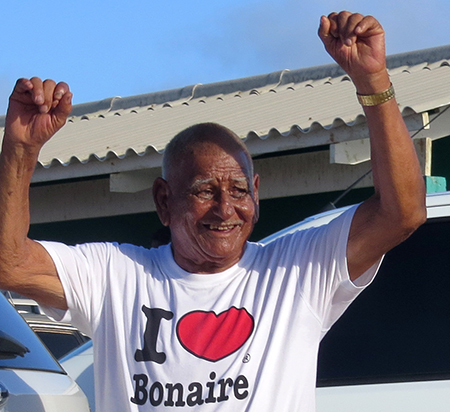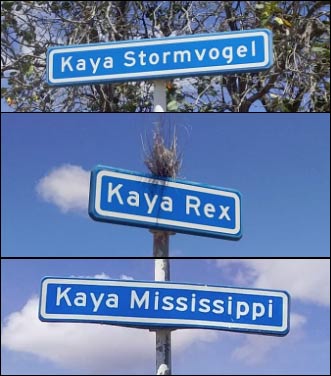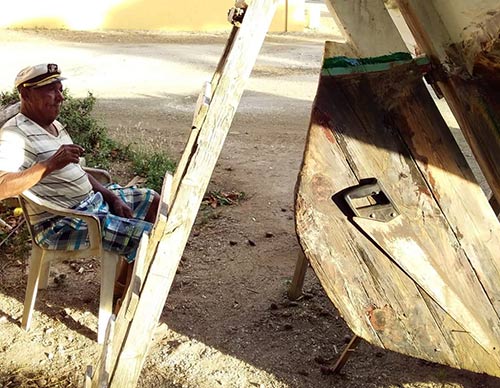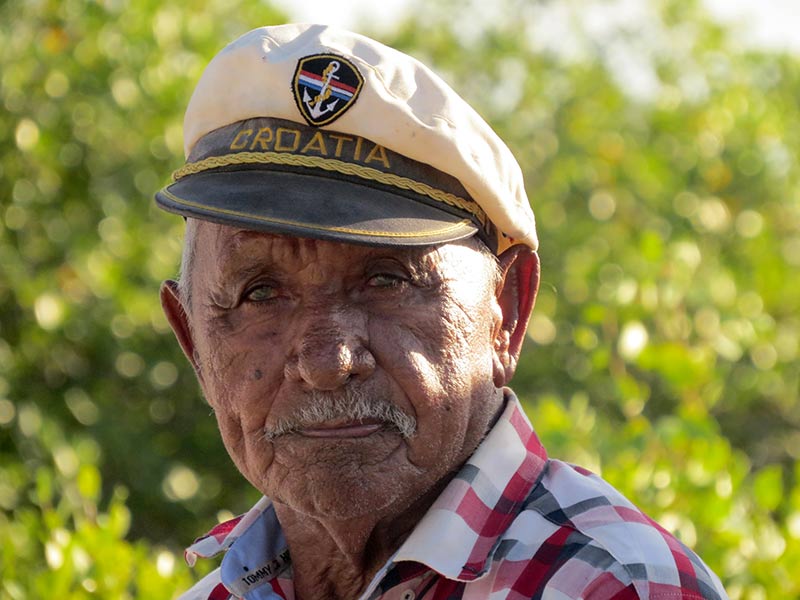Bonaire’s Men of the Sea–celebrating the maritime traditions that sustained Bonaire.
Every September and October, thoughts of many on the island turn to Bonaire’s men of the sea. These hardy souls, both those living and those no longer with us, who created the maritime traditions that sustained Bonaire for over a century.
The annual Regatta Festival has its roots in Bonaire’s men of the sea.
It could be due to the upcoming Regatta Festival, which began with the humble origin of two sailors vying for cases of beer and which has today turned into a music, food, and sailing festival that everyone can enjoy.
The Blessing of the Fishing Fleet, a tradition honored even today to keep the fisherman safe.
Or, it could be the recent Blessing of the Fishing Fleet, held early in September each year. This fine tradition brings together sailors from the island to pay homage to the Virgin del Valle, or The Virgin of the Valley, the patron saint of fishermen. On this day, the Virgin is thanked for her kindness over the past year in keeping the men of the fishing fleet safe from harm. Further, the fishermen ask for her continued safe-keeping for the next year.
It’s clear that the maritime traditions on Bonaire are still strong. It was a certain type of man who took to the sea, to support his family back home on Bonaire. And today, we celebrate those men, those now gone, as well as those still with us, who made their livings from the sea.
The first generation of Bonaire’s men of the sea.
It all started over 100 years ago when several fishermen from Venezuela found better fishing conditions here on Bonaire. Many of these fishermen had roots in the off-shore islands of Venezuela, such as Isla Margarita. But they came to Bonaire for better fishing and found homes near each other in the area called Playa Pariba. These men fell in love, married, had children, and stayed on Bonaire, and all their various families became “family” to each other. To this day, the descendents of those original men of the sea consider the other descendents as “family.”
In those days, there wasn’t enough call for fish on Bonaire, as the island was populated by only a few thousand people. These seamen had to leave their families to work elsewhere, and the Bonaire men of the sea become famous for their maritime skills, navigating, and boat-building. Many went to Cuba to work and sent money home to their families. Most came back, but some stayed on in Cuba, and, to this day, there are descendents of this first generation of Bonaire’s men of the sea who still live in Cuba.
The second generation of Bonaire’s men of the sea.
While the first generation of men was away sailing or working elsewhere in the Caribbean region, their young sons continued the seafaring traditions as they attained their maturity. Men such as Baselio Marin, Doei Diaz, Florensio Thode, Ismael Soliana, Ibo Domacasse, and men from the Gonzalez Family continued as fishermen, based on Bonaire. Over the years, as the island developed, some of these went into other maritime ventures, perhaps working on cargo ships plying the waters between Bonaire, Curacao, and Aruba or working on the island’s tugboats.
It was the second generation that began to create the bridge to other ways of making one’s living from the sea. Baselio Marin will be remembered by divers in the 1980s and 1990s who stayed at the Divi Flamingo Beach Resort and Casino, as he was a popular local divemaster there. He also was the one who single-handedly cut a channel at the northern dive site, Nukove, making that great reef accessible to shore diving. Sadly, Bas passed away in 2004.
Ibo Domacasse was another second generation seamen who also created a bridge to making a living in the burgeoning dive industry. Ibo is now known best for two wonderful dive sites named after him, Ebo’s Special and Ebo’s Reef.
Yet many stayed within the fishing industry. Doei Diaz continued to fish and sell his catch for many years. I recall visiting his house, where he would patiently clean and fillet whatever fish I chose. Back in those days (+/- 25 years ago), one could get a kilo (about 2.5 pounds) of fish for less than $5.00! Doei would carefully wrap the head and bones for me to take to make fish stock. But I would shake my head (actually back then I had no idea what I would do with them!). So he philosophically shrugged, and put them aside for his own use. You see, no part of the fish would ever be wasted.
Doei passed away earlier this year, just days before his beloved Ban Wapa ku Doei i Chana. This was the special Simadan celebration he and his wife, Chana, hosted each year.

The third generation.
Once again, the men from the second generation were living their lives, having children, and of course, the children were exposed to the sea at a young age. The third generation of Bonaire’s men of the sea are mostly still with us today, and many have completed the transition to making their livings from the sea in a different manner, with the visiting tourists!
Many visitors will recognize the names of Elvis Martinus (son of Doei Diaz and co-owner of Bonaire Windsurf Place), Eddy Statia , (a well-known divemaster), Patun Saragoza (Olympic windsurfer), and Etienne Soliana (also working professionally in the windsurfing industry), who is the son of Ismael Soliana.
And yet there is the fourth generation, stemming from Bonaire’s men of the sea.
The tradition continues with the fourth generation. Windsurf idols Tonki and Tati Frans, along with their cousin, Kiri Thode, have become world-renown for their tremendous windsurfing moves. They are the grand-children of first-generation Florensio Thode. We shall just have to wait and see what their fifth-generation children will accomplish in making their livings from the sea!
Other manifestations of the importance of Bonaire’s maritime history.
Playa Pabou street names honor old-time cargo sailing vessels.
- Kaya Mississippi
- Kaya Dialma
- Kaya Serena
- Kaya Rex
- Kaya America
- Kaya Stormvogel
- Kaya India
- Kaya Proud
- Kaya Niagara

And then there is Kaya P. N. Antonio Neuman, named after one of Bonaire’s sea captains.
Back in the 1940s, 1950s, and 1960s, sending and receiving cargo was only economically feasible via these famous and traditional sailing vessels.
Bonaire’s flag was created to represent the importance of maritime traditions.
 Bonaire’s flag represents the ocean and the maritime history of the island. The color blue represents the deep blue sea surrounding Bonaire; the color yellow represents the sun shining upon the island, the compass points show north, south, east, and west, to represent the importance of seafaring to Bonaire’s history.
Bonaire’s flag represents the ocean and the maritime history of the island. The color blue represents the deep blue sea surrounding Bonaire; the color yellow represents the sun shining upon the island, the compass points show north, south, east, and west, to represent the importance of seafaring to Bonaire’s history.Bonaire’s tradition of boat-building.
The oceanfront promenade fronting most of Kralendijk is named Kaya J. N. E. Craane and honors the first generation of the famous Craane family of boat-builders. Kachi Craane’s given name was Jan Nicolaas Erasmus Craane (1879-1974) and he was a seaman on a schooner. Kachi built more than 80 boats and tall ships in the yard of his house under the tamarind tree with the help of Johanse “Jonchi Pushi” Craane. In the late 1960s, descendents Johnny Craane and Luti Craane were tugboat captains, safely maneuvering in vessels carrying oil to Bopec. Another descendent, Buchi Craane, became a well-known captain in his own right at the harbour on the island of St. Maarten.
Interestingly enough, the building which houses the popular seafood restaurant, It Rains Fishes, is quite historical and is the location where the Craanes had their boat-building business. The building itself is over 100 years old, and was first known as the Kas di Pa Kachi Craane i Ma Seshi Craane-Graavenhorst (House of Pop Kachi Craane and Mom Seshi Craane-Graavenhorst).

Captain Ismael Soliana has one of the last traditional sailing boats made on Bonaire, named Etienne, after his son. Etienne is now out of the water, in dry dock at Ismael’s home, and, at ninety years of age, Ismael is lovingly restoring it to its former beauty in the manner of traditional boat-building.

52 years of Bonaire’s Sailing Regatta.
And, of course, with October just around the corner, everyone who is familiar with Bonaire is familiar with the island’s Sailing Regatta — a tradition which started 52 years ago with a bet between a local sea captain, Ibo Domacasse, and the then “new kid on the block,” Captain Don Stewart, for 27 cases of beer! That bet would lay the foundation for one of Bonaire’s most loved annual celebrations.
The maritime and fishing traditions on Bonare are hard-wired into the culture. Many Bonaireans can trace their own lineage back to one of the first generation of Bonaire’s famous seamen!
There’s so much to learn about these fast-disappearing skills that sustained Bonaire in its early days. Mangazina di Rei will focus upon these traditions at their Nos Zjilea cultural event this coming Saturday, September 28th, 2019 from 8:00 AM through 2:00 PM. If you are a history buff and would like to learn more, don’t miss this cultural event.
Source: Bonaire Insider Reporter












